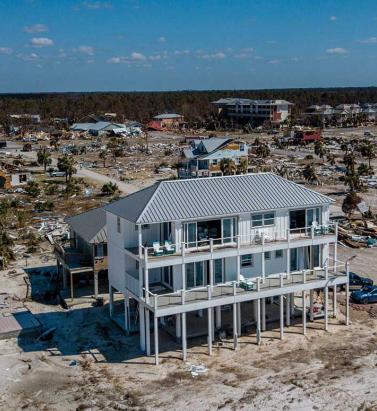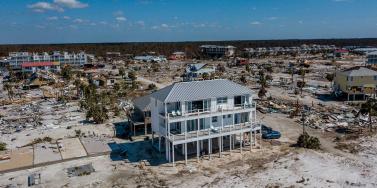Tag: Risk Data


The Data Difference
May 05, 2020The value of data as a driver of business decisions has grown exponentially as the importance of generating sustainable underwriting profit becomes the primary focus for companies in response to recent diminished investment yields. Increased risk selection scrutiny is more important than ever to maintain underwriting margins. High-caliber, insightful risk data is critical for the data analytics that support each risk decision The insurance industry is in a transformational phase where profit margins continue to be stretched in a highly competitive marketplace. Changing customer dynamics and new technologies are driving demand for more personalized solutions delivered in real time, while companies are working to boost performance, increase operational efficiency and drive greater automation. In some instances, this involves projects to overhaul legacy systems that are central to daily operation. In such a state of market flux, access to quality data has become a primary differentiator. But there’s the rub. Companies now have access to vast amounts of data from an expanding array of sources — but how can organizations effectively distinguish good data from poor data? What differentiates the data that delivers stellar underwriting performance from that which sends a combined operating performance above 100 percent? A Complete Picture “Companies are often data rich, but insight poor,” believes Jordan Byk, senior director, product management at RMS. “The amount of data available to the (re)insurance industry is staggering, but creating the appropriate insights that will give them a competitive advantage is the real challenge. To do that, data consumers need to be able to separate ‘good’ from ‘bad’ and identify what constitutes ‘great’ data.” For Byk, a characteristic of “great data” is the speed with which it drives confident decision-making that, in turn, guides the business in the desired direction. “What I mean by speed here is not just performance, but that the data is reliable and insightful enough that decisions can be made immediately, and all are confident that the decisions fit within the risk parameters set by the company for profitable growth. “While resolution is clearly a core component of our modeling capabilities at RMS, the ultimate goal is to provide a complete data picture and ensure quality and reliability of underlying data” Oliver Smith RMS “We’ve solved the speed and reliability aspect by generating pre-compiled, model-derived data at resolutions intelligent for each peril,” he adds. There has been much focus on increasing data-resolution levels, but does higher resolution automatically elevate the value of data in risk decision-making? The drive to deliver data at 10-, five- or even one-meter resolution may not necessarily be the main ingredient in what makes truly great data. “Often higher resolution is perceived as better,” explains Oliver Smith, senior product manager at RMS, “but that is not always the case. While resolution is clearly a core component of our modeling capabilities at RMS, the ultimate goal is to provide a complete data picture and ensure quality and reliability of underlying data. “Resolution of the model-derived data is certainly an important factor in assessing a particular exposure,” adds Smith, “but just as important is understanding the nature of the underlying hazard and vulnerability components that drive resolution. Otherwise, you are at risk of the ‘garbage-in-garbage-out’ scenario that can foster a false sense of reliability based solely around the ‘level’ of resolution.” The Data Core The ability to assess the impact of known exposure data is particularly relevant to the extensive practice of risk scoring. Such scoring provides a means of expressing a particular risk as a score from 1 to 10, 1 to 20 or another means that indicates “low risk to high risk” based on an underlying definition for each value. This enables underwriters to make quick submission assessments and supports critical decisions relating to quoting, referrals and pricing. “Such capabilities are increasingly common and offer a fantastic mechanism for establishing underwriting guidelines, and enabling prioritization and triage of locations based on a consistent view of perceived riskiness,” says Chris Sams, senior product manager at RMS. “What is less common, however, is ‘reliable’ and superior quality risk scoring, as many risk scores do not factor in readily available vulnerability data.” “Such capabilities are increasingly common and offer a fantastic mechanism for establishing underwriting guidelines, and enabling prioritization and triage of locations based on a consistent view of perceived riskiness” Chris Sams RMS Exposure insight is created by adjusting multiple data lenses until the risk image comes into focus. If particular lenses are missing or there is an overreliance on one particular lens, the image can be distorted. For instance, an overreliance on hazard-related information can significantly alter the perceived exposure levels for a specific asset or location. “Take two locations adjacent to one another that are exposed to the same wind or flood hazard,” Byk says. “One is a high-rise hotel built in 2020 and subject to the latest design standards, while another is a wood-frame, small commercial property built in the 1980s; or one location is built at ground level with a basement, while another is elevated on piers and does not have a basement. “These vulnerability factors will result in a completely different loss experience in the occurrence of a wind- or flood-related event. If you were to run the locations through our models, the annual average loss figures will vary considerably. But if the underwriting decision is based on hazard-only scores, they will look the same until they hit the portfolio assessment — and that’s when the underwriter could face some difficult questions.” To assist clients to understand the differences in vulnerability factors, RMS provides ExposureSource, a U.S. property database comprised of property characteristics for 82 million residential buildings and 21 million commercial buildings. By providing this high-quality exposure data set, clients can make the most of the RMS risk scoring products for the U.S. Seeing Through the Results Another common shortfall with risk scores is the lack of transparency around the definitions attributed to each value. Looking at a scale of 1 to 10, for example, companies don’t have insight into the exposure characteristics being used to categorize a particular asset or location as, say, a 4 rather than a 5 or 6. To combat data-scoring deficiencies, RMS RiskScore values are generated by catastrophe models incorporating the trusted science and quality you expect from an RMS model, calibrated on billions of dollars of real-world claims. With consistent and reliable risk scores covering 30 countries and up to seven perils, the apparent simplicity of the RMS RiskScore hides the complexity of the big data catastrophe simulations that create them. The scores combine hazard and vulnerability to understand not only the hazard experienced at a site, but also the susceptibility of a particular building stock when exposed to a given level of hazard. The RMS RiskScore allows for user definition of exposure characteristics such as occupancy, construction material, building height and year built. Users can also define secondary modifiers such as basement presence and first-floor height, which are critical for the assessment of flood risk, and roof shape or roof cover, which is critical for wind risk. “It also provides clearly structured definitions for each value on the scale,” explains Smith, “providing instant insight on a risk’s damage potential at key return periods, offering a level of transparency not seen in other scoring mechanisms. For example, a score of 6 out of 10 for a 100-year earthquake event equates to an expected damage level of 15 to 20 percent. This information can then be used to support a more informed decision on whether to decline, quote or refer the submission. Equally important is that the transparency allows companies to easily translate the RMS RiskScore into custom scales, per peril, to support their business needs and risk tolerances.” Model Insights at Point of Underwriting While RMS model-derived data should not be considered a replacement for the sophistication offered by catastrophe modeling, it can enable underwriters to access relevant information instantaneously at the point of underwriting. “Model usage is common practice across multiple points in the (re)insurance chain for assessing risk to individual locations, accounts, portfolios, quantifying available capacity, reinsurance placement and fulfilling regulatory requirements — to name but a few,” highlights Sams. “However, running the model takes time, and, often, underwriting decisions — particularly those being made by smaller organizations — are being made ahead of any model runs. By the time the exposure results are generated, the exposure may already be at risk.” “Through this interface, companies gain access to the immense datasets that we maintain in the cloud and can simply call down risk decision information whenever they need it” Jordan Byk RMS In providing a range of data products into the process, RMS is helping clients select, triage and price risks before such critical decisions are made. The expanding suite of data assets is generated by its probabilistic models and represents the same science and expertise that underpins the model offering. “And by using APIs as the delivery vehicle,” adds Byk, “we not only provide that modeled insight instantaneously, but also integrate that data directly and seamlessly into the client’s on-premise systems at critical points in their workflow. Through this interface, companies gain access to the immense datasets that we maintain in the cloud and can simply call down risk decision information whenever they need it. While these are not designed to compete with a full model output, until a time that we have risk models that provide instant analysis, such model-derived datasets offer the speed of response that many risk decisions demand.” A Consistent and Broad Perspective on Risk A further factor that can instigate problems is data and analytics inconsistency across the (re)insurance workflow. Currently, with data extracted from multiple sources and, in many cases, filtered through different lenses at various stages in the workflow, having consistency from the point of underwriting to portfolio management has been the norm. “There is no doubt that the disparate nature of available data creates a disconnect between the way risks are assumed into the portfolio and how they are priced,” Smith points out. “This disconnect can cause ‘surprises’ when modeling the full portfolio, generating a different risk profile than expected or indicating inadequate pricing. By applying data generated via the same analytics and data science that is used for portfolio management, consistency can be achieved for underwriting risk selection and pricing, minimizing the potential for surprise.” Equally important, given the scope of modeled data required by (re)insurance companies, is the need to focus on providing users with the means to access the breadth of data from a central repository. “If you access such data at speed, including your own data coupled with external information, and apply sophisticated analytics — that is how you derive truly powerful insights,” he concludes. “Only with that scope of reliable, insightful information instantly accessible at any point in the chain can you ensure that you’re always making fully informed decisions — that’s what great data is really about. It’s as simple as that.” For further information on RMS’s market-leading data solutions, click here.


This Changes Everything
May 05, 2020At Exceedance 2020, RMS explored the key forces currently disrupting the industry, from technology, data analytics and the cloud through to rising extremes of catastrophic events like the pandemic and climate change. This coupling of technological and environmental disruption represents a true inflection point for the industry. EXPOSURE asked six experts across RMS for their views on why they believe these forces will change everything Cloud Computing: Moe Khosravy, Executive Vice President, Software and Platforms How are you seeing businesses transition their workloads over to the cloud? I have to say it’s been remarkable. We’re way past basic conversations on the value proposition of the cloud to now having deep technical discussions that are truly transformative plays. Customers are looking for solutions that seamlessly scale with their business and platforms that lower their cost of ownership while delivering capabilities that can be consumed from anywhere in the world. Why is the cloud so important or relevant now? It is now hard for a business to beat the benefits that the cloud offers and getting harder to justify buying and supporting complex in-house IT infrastructure. There is also a mindset shift going on — why is an in-house IT team responsible for running and supporting another vendor’s software on their systems if the vendor itself can provide that solution? This burden can now be lifted using the cloud, letting the business concentrate on what it does best. Has the pandemic affected views of being in the cloud? I would say absolutely. We have always emphasized the importance of cloud and true SaaS architectures to enable business continuity — allowing you to do your work from anywhere, decoupled from your IT and physical footprint. Never has the importance of this been more clearly underlined than during the past few months. Risk Analytics: Cihan Biyikoglu, Executive Vice President, Product What are the specific industry challenges that risk analytics is solving or has the potential to solve? Risk analytics really is a wide field, but in the immediate short term one of the focus areas for us is improving productivity around data. So much time is spent by businesses trying to manually process data — cleansing, completing and correcting data — and on conversion between incompatible datasets. This alone is a huge barrier just to get a single set of results. If we can take this burden away, give decision-makers the power to get results in real time with automated and efficient data handling, then with that I believe we will liberate them to use the latest insights to drive business results. Another important innovation here are the HD Models™. The power of the new engine with its improved accuracy I believe is a game changer that will give our customers a competitive edge. How will risk analytics impact activities and capabilities within the market? As seen in other industries, the more data you can combine, the better the analytics become — that’s the universal law of analytics. Getting all of this data on a unified platform and combining different datasets unearths new insights, which could produce opportunities to serve customers better and drive profit or growth. What are the longer-term implications for risk analytics? In my view, it’s about generating more effective risk insights from analytics, results in better decision- making and the ability to explore new product areas with more confidence. It will spark a wave of innovation to profitably serve customers with exciting products and understand the risk and cost drivers more clearly. How is RMS capitalizing on risk analytics? At RMS, we have the pieces in place for clients to accelerate their risk analytics with the unified, open platform, Risk Intelligence™, which is built on a Risk Data Lake™ in the cloud and is ready to take all sources of data and unearth new insights. Applications such as Risk Modeler™ and ExposureIQ™ can quickly get decision-makers to the analytics they need to influence their business. Open Standards: Dr. Paul Reed, Technical Program Manager, RDOS Why are open standards so important and relevant now? I think the challenges of risk data interoperability and supporting new lines of business have been recognized for many years, as companies have been forced to rework existing data standards to try to accommodate emerging risks and to squeeze more data into proprietary standards that can trace their origins to the 1990s. Today, however, with the availability of big data technology, cloud platforms such as RMS Risk Intelligence and standards such as the Risk Data Open Standard™ (RDOS) allow support for high-resolution risk modeling, new classes of risk, complex contract structures and simplified data exchange. Are there specific industry challenges that open standards are solving or have the potential to solve? I would say that open standards such as the RDOS are helping to solve risk data interoperability challenges, which have been hindering the industry, and provide support for new lines of business. In the case of the RDOS, it’s specifically designed for extensibility, to create a risk data exchange standard that is future-proof and can be readily modified and adapted to meet both current and future requirements. Open standards in other industries, such as Kubernetes, Hadoop and HTML, have proven to be catalysts for collaborative innovation, enabling accelerated development of new capabilities. How is RMS responding to and capitalizing on this development? RMS contributed the RDOS to the industry, and we are using it as the data framework for our platform called Risk Intelligence. The RDOS is free for anyone to use, and anyone can contribute updates that can expand the value and utility of the standard — so its development and direction is not dependent on a single vendor. We’ve put in place an independent steering committee to guide the development of the standard, currently made up of 15 companies. It provides benefits to RMS clients not only by enhancing the new RMS platform and applications, but also by enabling other industry users who create new and innovative products and address new and emerging risk classes. Pandemic Risk: Dr. Gordon Woo, Catastrophist How does pandemic risk affect the market? There’s no doubt that the current pandemic represents a globally systemic risk across many market sectors, and insurers are working out both what the impact from claims will be and the impact on capital. For very good reasons, people are categorizing the COVID-19 disease as a game-changer. However, in my view, SARS [severe acute respiratory syndrome] in 2003, MERS [Middle East respiratory syndrome] in 2012 and Ebola in 2014 should also have been game-changers. Over the last decade alone, we have seen multiple near misses. It’s likely that suppression strategies to combat the coronavirus will probably continue in some form until a vaccine is developed, and governments must strike this uneasy balance between their economies and the opening of their populations to exposure from the virus. What are the longer-term implications of this current pandemic for the industry? It’s clear that the mitigation of pandemic risk will need to be prioritized and given far more urgency than before. There’s no doubt in my mind that events such as the 2014 Ebola crisis were a missed opportunity for new initiatives in pandemic risk mitigation. Away from the life and health sector, all insurers will need to have a better grasp on future pandemics, after seeing the impact of COVID-19 and its wide business impact. The market could look to bold initiatives with governments to examine how to cover future pandemics, similar to how terror attacks are covered as a pooled risk. How is RMS helping its clients in relation to COVID-19? Since early January when the first cases emerged from Wuhan, China, we’ve been supporting our clients and the wider market in gaining a better understanding of the diverse loss implications of COVID-19. Our LifeRisks® team has been actively assisting in pandemic risk management, with regular communications and briefings, and will incorporate new perspectives from COVID-19 into our infectious diseases modeling. Climate Change: Ryan Ogaard, Senior Vice President, Model Product Management Why is climate change so relevant to the market now? There are many reasons. Insurers and their stakeholders are looking at the constant flow of catastrophes, from the U.S. hurricane season of 2017, wildfires in California and bushfires in Australia, to recent major typhoons and wondering if climate change is driving extreme weather risk, and what it could do in the future. They’re asking whether the current extent of climate change risk is priced into their premiums. Regulators are also beginning to conduct stress tests on the potential impact of climate change in the future, and insurers must respond. How will climate change impact how the market operates? Similar to any risk, insurers need to understand and quantify how the physical risk of climate change will impact their portfolios and adjust their strategy accordingly. Also, over the coming years it appears likely that regulators will incorporate climate change reporting into their regimes. Once an insurer understands their exposure to climate change risk, they can then start to take action — which will impact how the market operates. These actions could be in the form of premium changes, mitigating actions such as supporting physical defenses, diversifying the risk or taking on more capital. How is RMS responding to market needs around climate change? RMS is listening to the needs of clients to understand their pain points around climate change risk, what actions they are taking and how we can add value. We’re working with a number of clients on bespoke studies that modify the current view of risk to project into the future and/or test the sensitivity of current modeling assumptions. We’re also working to help clients understand the extent to which climate change is already built into risk models, to educate clients on emerging climate change science and to explain whether there is or isn’t a clear climate change signal for a particular peril. Cyber: Dr. Christos Mitas, Vice President, Model Development How is this change currently manifesting itself? While cyber risk itself is not new, for anyone involved in protecting or insuring organizations against cyberattacks, they will know that the nature of cyber risk is forever evolving. This could involve changes in those perpetrating the attacks, from lone wolf criminals to state-backed actors or the type of target from an unpatched personal computer to a power-plant control system. If you take the current COVID-19 pandemic, this has seen cybercriminals look to take advantage of millions of employees working from home or vulnerable business IT infrastructure. Change to the threat landscape is a constant for cyber risk. Why is cyber risk so important and relevant right now? Simply because new cyber risks emerge, and insurers who are active in this area need to ensure they are ahead of the curve in terms of awareness and have the tools and knowledge to manage new risks. There have been systemic ransomware attacks over the last few years, and criminals continue to look for potential weaknesses in networked systems, third-party software, supply chains — all requiring constant vigilance. It’s this continual threat of a systemic attack that requires insurers to use effective tools based on cutting-edge science, to capture the latest threats and identify potential risk aggregation. How is RMS responding to market needs around cyber risk? With our latest RMS Cyber Solutions, which is version 4.0, we’ve worked closely with clients and the market to really understand the pain points within their businesses, with a wealth of new data assets and modeling approaches. One area is the ability to know the potential cyber risk of the type of business you are looking to insure. In version 4.0, we have a database of over 13 million businesses that can help enrich the information you have about your portfolio and prospective clients, which then leads to more prudent and effective risk modeling. A Time to Change Our industry is undergoing a period of significant disruption on multiple fronts. From the rapidly evolving exposure landscape and the extraordinary changes brought about by the pandemic to step-change advances in technology and seismic shifts in data analytics capabilities, the market is undergoing an unparalleled transition period. As Exceedance 2020 demonstrated, this is no longer a time for business as usual. This is what defines leaders and culls the rest. This changes everything.


A Solution Shared
May 05, 2020The Risk Data Open Standard is now available, and active industry collaboration is essential for achieving wide-scale interoperability objectives On January 31, the first version of the Risk Data Open Standard™ (RDOS) was made available to the risk community and the public on the GitHub platform. The RDOS is an “open” standard because it is available with no fees or royalties and anyone can review, download, contribute to or leverage the RDOS for their own project. With the potential to transform the way risk data is expressed and exchanged across the (re)insurance industry and beyond, the RDOS represents a new data model (i.e., a data specification or schema) specifically designed for holding all types of risk data, from exposure through model settings to results analyses. The industry has longed recognized that a dramatic improvement in risk data container design is required to support current and future industry operations. The industry currently relies on data models for risk data exchange and storage that were originally designed to support property cat models over 20 years ago. These formats are incomplete. They do not capture critical information about contracts, business structures or model settings. This means that an analyst receiving data in these old formats has detective work to do – filling in the missing pieces of the risk puzzle. Because formats lack a complete picture linking exposures to results, highly skilled, well-paid people are wasting a huge amount of time, and efforts to automate are difficult, if not impossible, to achieve. Existing formats are also very property-centric. As models for new insurance lines have emerged over the years, such as energy, agriculture and cyber, the risk data for these lines of business have either been forced suboptimally into the property cat data model, or entirely new formats have been created to support single lines of business. The industry is faced with two poor choices: accept substandard data or deal with many data formats – potentially one for each line of business – possibly multiplied by the number of companies who offer models for a particular line of business. The industry is painfully aware of the problems we are trying to solve. The RDOS aims to provide a complete, flexible and interoperable data format ‘currency’ for exchange that will eliminate the time-consuming and costly data processes that are currently required Paul Reed RMS “The industry is painfully aware of the problems we are trying to solve. The RDOS aims to provide a complete, flexible and interoperable data format ‘currency’ for exchange that will eliminate the time-consuming and costly data processes that are currently required,” explains Paul Reed, technical program manager for the RDOS at RMS. He adds, “Of course, adoption of a new standard can’t happen overnight, but because it is backward-compatible with the RMS EDM and RDM users have optionality through the transition period.” Taking on the Challenge The RDOS has great promise. An open standard specifically designed to represent and exchange risk data, it accommodates all categories of risk information across five critical information sets – exposure, contracts (coverage), business structures, model settings and results analyses. But can it really overcome the many intrinsic data hurdles currently constraining the industry? According to Ryan Ogaard, senior vice president of model product management at RMS, its ability to do just that lies in the RDOS’s conceptual entity model. “The design is simple, yet complete, consisting of these five linked categories of information that provide an unambiguous, auditable view of risk analysis,” he explains. “Each data category is segregated – creating flexibility by isolating changes to any given part of the RDOS – but also linked in a single container to enable clear navigation through and understanding of any risk analysis, from the exposure and contracts through to the results.” By adding critical information about the business structure and models used, the standard creates a complete data picture – a fully traceable description of any analysis. This unique capability is a result of the superior technical data model design that the RDOS brings to the data struggle, believes Reed. “The RDOS delivers multiple technical advantages,” he says. “Firstly, it stores results data along with contracts, business structure and settings data, which combine to enable a clear and comprehensive understanding of analyses. Secondly, the contract definition language (CDL) and structure definition language (SDL) provide a powerful tool for unambiguously determining contract payouts from a set of claims. In addition, the data model design supports advanced database technology and can be implanted in several popular DB formats including object-relational and SQL. Flexibility has been designed into virtually every facet of the RDOS, with design for extensibility built into each of the five information entities.” “New information sets can be introduced to the RDOS without impacting existing information,” Ogaard says. “This overcomes the challenges of model rigidity and provides the flexibility to capture multivendor modeling data, as well as the user’s own view of risk. This makes the standard future-proof and usable by a broad cross section of the (re)insurance industry and other industries.” Opening Up the Standard To achieve the ambitious objective of risk data interoperability, it was critical that the RDOS was founded on an open-source platform. Establishing the RDOS on the GitHub platform was a game-changing decision, according to Cihan Biyikoglu, executive vice president of product at RMS. You have to recognize the immense scale of the data challenge that exists within the risk analysis field. To address it effectively will require a great deal of collaboration across a broad range of stakeholders. Having the RDOS as an open standard enables that scale of collaboration to occur. “I’ve worked on a number of open-source projects,” he says, “and in my opinion an open-source standard is the most effective way of energizing an active community of contributors around a particular project. “You have to recognize the immense scale of the data challenge that exists within the risk analysis field. To address it effectively will require a great deal of collaboration across a broad range of stakeholders. Having the RDOS as an open standard enables that scale of collaboration to occur.” Concerns have been raised about whether, given its open-source status and the ambition to become a truly industrywide standard, RMS should continue to play a leading role in the ongoing development of the RDOS now that it is open to all. Biyikoglu believes it should. “Many open-source projects start with a good initial offering but are not maintained over time and quickly become irrelevant. If you look at the successful projects, a common theme is that they emanate from an industry participant suffering greatly from the particular issue. In the early phase, they contribute the majority of the improvements, but as the project evolves and the active community expands, the responsibility for moving it forward is shared by all. And that is exactly what we expect to see with the RDOS.” For Paul Reed, the open-source model provides a fair and open environment in which all parties can freely contribute. “By adopting proven open-source best practices and supported by the industry-driven RDOS Steering Committee, we are creating a level playing field in which all participants have an equal opportunity to contribute.” Assessing The Potential Following the initial release of the RDOS, much of the activity on the GitHub platform has involved downloading and reviewing the RDOS data model and tools, as users look to understand what it can offer and how it will function. However, as the open RDOS community builds and contributions are received, combined with guidance from industry experts on the steering committee, Ogaard is confident it will quickly start generating clear value on multiple fronts. “The flexibility, adaptability and completeness of the RDOS structure create the potential to add tremendous industry value,” he believes, “by addressing the shortcomings of current data models in many areas. There is obvious value in standardized data for lines of business beyond property and in facilitating efficiency and automation. The RDOS could also help solve model interoperability problems. It’s really up to the industry to set the priorities for which problem to tackle first. The flexibility, adaptability and completeness of the RDOS structure create the potential to add tremendous industry value “Existing data formats were designed to handle property data,” Ogaard continues, “and do not accommodate new categories of exposure information. The RDOS Risk Item entity describes an exposure and enables new Risk Items to be created to represent any line of business or type of risk, without impacting any existing Risk Item. That means a user could add marine as a new type of Risk Item, with attributes specific to marine, and define contracts that cover marine exposure or its own loss type, without interfering with any existing Risk Item.” The RDOS is only in its infancy, and how it evolves – and how quickly it evolves – lies firmly in the hands of the industry. RMS has laid out the new standard in the GitHub open-source environment and, while it remains committed to the open standard’s ongoing development, the direction that the RDOS takes is firmly in the hands of the (re)insurance community. Access the Risk Data Open Standard here


The Art of Empowerment
May 20, 2019A new app – SiteIQ™ from RMS intuitively synthesizes complex risk data for a single location, helping underwriters and coverholders to rate and select risks at the touch of a button The more holistic view of risk a property underwriter can get, the better decisions they are likely to make. In order to build up a detailed picture of risk at an individual location, underwriters or agents at coverholders have, until now, had to request exposure analytics on single risks from their portfolio managers and brokers. Also, they had to gather supplementary risk data from a range of external resources, whether it is from Catastrophe Risk Evaluation and Standardizing Target Accumulations (CRESTA) zones to look-ups on Google Maps. This takes valuable time, requires multiple user licenses and can generate information that is inconsistent with the underlying modeling data at the portfolio level. As the senior manager at one managing general agent (MGA) tells EXPOSURE, this misalignment of data means underwriting decisions are not always being made with confidence. This makes the buildup of unwanted risk aggregation in a particular area a very real possibility, invariably resulting in “senior management breathing down my neck.” With underwriters in desperate need of better multi-peril data at the point of underwriting, RMS has developed an app, SiteIQ, that leverages sophisticated modeling information, as well as a view of the portfolio of locations underwritten, to be easily understood and quickly actionable at the point of underwriting. But it also goes further as SiteIQ can integrate with a host of data providers so users can enter any address into the app and quickly see a detailed breakdown of the natural and human-made hazards that may put the property at risk. SiteIQ allows the underwriter to generate detailed risk scores for each location in a matter of seconds In addition to synthesized RMS data, users can also harness third-party risk data to overlay responsive map layers such as, arson, burglary and fire-protection insights, and other indicators that can help the underwriter better understand the characteristics of a building and assess whether it is well maintained or at greater risk. The app allows the underwriter to generate detailed risk scores for each location in a matter of seconds. It also assigns a simple color coding for each hazard, in line with the insurer’s appetite: whether that’s green for acceptable levels of risk all the way to red for risks that require more complex analysis. Crucially, users can view individual locations in the context of the wider portfolio, helping them avoid unwanted risk aggregation and write more consistently to the correct risk appetite. The app goes a level further by allowing clients to use a sophisticated rules engine that takes into account the client’s underwriting rules. This enables SiteIQ to recommend possible next steps for each location — whether that’s to accept the risk, refer it for further investigation or reject it based on breaching certain criteria. “We decided to build an app exclusively for underwriters to help them make quick decisions when assessing risks,” explains Shaheen Razzaq, senior director at RMS. “SiteIQ provides a systematic method to identify locations that don’t meet your risk strategy so you can focus on finding the risks that do. “People are moving toward simple digital tools that synthesize information quickly,” he adds. “Underwriters tell us they want access to science without having to rely on others and the ability to screen and understand risks within seconds.” And as the underlying data behind the application is based on the same RMS modeling information used at the portfolio level, this guarantees data consistency at all points in the chain. “Deep RMS science, including data from all of our high-definition models, is now being delivered to people upstream, building consistency and understanding,” says Razzaq. SiteIQ has made it simple to build in the customer’s risk appetite and their view of risk. “One of the major advantages of the app is that it is completely configurable by the customer. This could be assigning red-amber-green to perils with certain scores, setting rules for when it should recommend rejecting a location, or integrating a customer’s proprietary data that may have been developed using their underwriting and claims experience — which is unique to each company.” Reporting to internal and external stakeholders is also managed by the app. And above all, says Razzaq, it is simple to use, priced at an accessible level and requires no technical skill, allowing underwriters to make quick, informed decisions from their desktops and tablet devices — and soon their smartphones. In complex cases where deeper analysis is required or when models should be run, working together with cat modelers will still be a necessity. But for most risks, underwriters will be able to quickly screen and filter risk factors, reducing the need to consult their portfolio managers or cat modeling teams. “With underwriting assistants a thing of the past, and the expertise the cat modelers offer being a valuable but finite resource, it’s our responsibility to understand risk at the point of underwriting,” one underwriter explains. “As a risk decision-maker, when I need to make an assessment on a particular location, I need access to insights in a timely and efficient manner, so that I can make the best possible decision based on my business,” another underwriter adds. The app is not intended to replace the deep analysis that portfolio management teams do, but instead reduce the number of times they are asked for information by their underwriters, giving them more time to focus on the job at hand — helping underwriters assess the most complex of risks. Bringing Coverholders on Board Similar efficiencies can be gained on cover-holder/delegated-authority business. In the past, there have been issues with cover-holders providing coverage that takes a completely different view of risk to the syndicate or managing agent that is providing the capacity. RMS has ensured SiteIQ works for coverholders, to give them access to shared analytics, managing agent rules and an enhanced view of hazards. It is hoped this will both improve underwriting decision-making by the coverholders and strengthen delegated-authority relationships. Coverholder business continues to grow in the Lloyd’s and company markets, and delegating authorities often worry whether the risks underwritten on their behalf are done so with the best possible information available. A better scenario is when the coverholder contacts the delegating authority to ask for advice on a particular location, but receiving multiple referral calls each day from coverholders seeking decisions on individual risks can be a drain on these growing businesses’ resources. “Delegated authorities obviously want coverholders to write business doing the proper risk assessments, but on the other hand, if the coverholder is constantly pinging the managing agent for referrals, they aren’t a good partner,” says a senior manager at one MGA. “We can increase profitability if we improve our current workflow, and that can only be done with smart tools that make risk management simpler,” he notes, adding that better risk information tools would allow his company to redeploy staff. A recent Lloyd’s survey found that 55 percent of managing agents are struggling with resources in their delegated-authority teams. And with the Lloyd’s Corporation also seeking to cleanse the market of sub-par performers after swinging to a loss in 2018, any solution that drives efficiency and enables coverholders to make more informed decisions can only help drive up standards. “It was actually an idea that stemmed from our clients’ underwriting coverholder business. If we can equip coverholders with these tools, managing agents will receive fewer phone calls while being confident that the coverholder is writing good business in line with the agreed rules,” says Razzaq. “Most coverholders lack the infrastructure, budget and human resources to run complex models. With SiteIQ, RMS can now offer them deeper analytics, by leveraging expansive model science, in a more accessible way and at a more affordable price.”


Underwriting With 20:20 Vision
May 20, 2019Risk data delivered to underwriting platforms via application programming interfaces (API) is bringing granular exposure information and model insights to high-volume risks The insurance industry boasts some of the most sophisticated modeling capabilities in the world. And yet the average property underwriter does not have access to the kind of predictive tools that carriers use at a portfolio level to manage risk aggregation, streamline reinsurance buying and optimize capitalization. Detailed probabilistic models are employed on large and complex corporate and industrial portfolios. But underwriters of high-volume business are usually left to rate risks with only a partial view of the risk characteristics at individual locations, and without the help of models and other tools. “There is still an insufficient amount of data being gathered to enable the accurate assessment and pricing of risks [that] our industry has been covering for decades,” says Talbir Bains, founder and CEO of managing general agent (MGA) platform Volante Global. Access to insights from models used at the portfolio level would help underwriters make decisions faster and more accurately, improving everything from risk screening and selection to technical pricing. However, accessing this intellectual property (IP) has previously been difficult for higher-volume risks, where to be competitive there simply isn’t the time available to liaise with cat modeling teams to configure full model runs and build a sophisticated profile of the risk. Many insurers invest in modeling post-bind in order to understand risk aggregation in their portfolios, but Ross Franklin, senior director of data product management at RMS, suggests this is too late. “From an underwriting standpoint, that’s after the horse has bolted — that insight is needed upfront when you are deciding whether to write and at what price.” By not seeing the full picture, he explains, underwriters are often making decisions with a completely different view of risk from the portfolio managers in their own company. “Right now, there is a disconnect in the analytics used when risks are being underwritten and those used downstream as these same risks move through to the portfolio.” Cut off From the Insight Historically, underwriters have struggled to access complete information that would allow them to better understand the risk characteristics at individual locations. They must manually gather what risk information they can from various public- and private-sector sources. This helps them make broad assessments of catastrophe exposures, such as FEMA flood zone or distance to coast. These solutions often deliver data via web portals or spreadsheets and reports — not into the underwriting systems they use every day. There has been little innovation to increase the breadth, and more importantly, the usability of data at the point of underwriting. “Vulnerability is critical to accurate underwriting. Hazard alone is not enough” Ross Franklin RMS “We have used risk data tools but they are too broad at the hazard level to be competitive — we need more detail,” notes one senior property underwriter, while another simply states: “When it comes to flood, honestly, we’re gambling.” Misaligned and incomplete information prevents accurate risk selection and pricing, leaving the insurer open to negative surprises when underwritten risks make their way onto the balance sheet. Yet very few data providers burrow down into granular detail on individual risks by identifying what material a property is made of, how many stories it is, when it was built and what it is used for, for instance, all of which can make a significant difference to the risk rating of that individual property. “Vulnerability is critical to accurate underwriting. Hazard alone is not enough. When you put building characteristics together with the hazard information, you form a deeper understanding of the vulnerability of a specific property to a particular hazard. For a given location, a five-story building built from reinforced concrete in the 1990s will naturally react very differently in a storm than a two-story wood-framed house built in 1964 — and yet current underwriting approaches often miss this distinction,” says Franklin. In response to demand for change, RMS developed a Location Intelligence application programming interface (API), which allows preformatted RMS risk information to be easily distributed from its cloud platform via the API into any third-party or in-house underwriting software. The technology gives underwriters access to key insights on their desktops, as well as informing fully automated risk screening and pricing algorithms. The API allows underwriters to systematically evaluate the profitability of submissions, triage referrals to cat modeling teams more efficiently and tailor decision-making based on individual property characteristics. It can also be overlaid with third-party risk information. “The emphasis of our latest product development has been to put rigorous cat peril risk analysis in the hands of users at the right points in the underwriting workflow,” says Franklin. “That’s a capability that doesn’t exist today on high-volume personal lines and SME business, for instance.” Historically, underwriters of high-volume business have relied on actuarial analysis to inform technical pricing and risk ratings. “This analysis is not usually backed up by probabilistic modeling of hazard or vulnerability and, for expediency, risks are grouped into broad classes. The result is a loss of risk specificity,” says Franklin. “As the data we are supplying derives from the same models that insurers use for their portfolio modeling, we are offering a fully connected-up, consistent view of risk across their property books, from inception through to reinsurance.” With additional layers of information at their disposal, underwriters can develop a more comprehensive risk profile for individual locations than before. “In the traditional insurance model, the bad risks are subsidized by the good — but that does not have to be the case. We can now use data to get a lot more specific and generate much deeper insights,” says Franklin. And if poor risks are screened out early, insurers can be much more precise when it comes to taking on and pricing new business that fits their risk appetite. Once risks are accepted, there should be much greater clarity on expected costs should a loss occur. The implications for profitability are clear. Harnessing Automation While improved data resolution should drive better loss ratios and underwriting performance, automation can attack the expense ratio by stripping out manual processes, says Franklin. “Insurers want to focus their expensive, scarce underwriting resources on the things they do best — making qualitative expert judgments on more complex risks.” This requires them to shift more decision-making to straight-through processing using sophisticated underwriting guidelines, driven by predictive data insight. Straight-through processing is already commonplace in personal lines and is expected to play a growing role in commercial property lines too. “Technology has a critical role to play in overcoming this data deficiency through greatly enhancing our ability to gather and analyze granular information, and then to feed that insight back into the underwriting process almost instantaneously to support better decision-making,” says Bains. “However, the infrastructure upon which much of the insurance model is built is in some instances decades old and making the fundamental changes required is a challenge.” Many insurers are already in the process of updating legacy IT systems, making it easier for underwriters to leverage information such as past policy information at the point of underwriting. But technology is only part of the solution. The quality and granularity of the data being input is also a critical factor. Are brokers collecting sufficient levels of data to help underwriters assess the risk effectively? That’s where Franklin hopes RMS can make a real difference. “For the cat element of risk, we have far more predictive, higher-quality data than most insurers use right now,” he says. “Insurers can now overlay that with other data they hold to give the underwriter a far more comprehensive view of the risk.” Bains thinks a cultural shift is needed across the entire insurance value chain when it comes to expectations of the quantity, quality and integrity of data. He calls on underwriters to demand more good quality data from their brokers, and for brokers to do the same of assureds. “Technology alone won’t enable that; the shift is reliant upon everyone in the chain recognizing what is required of them.”



